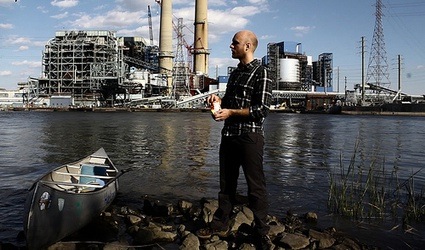 Photo credit: Elisa Giardina Papa
Photo credit: Elisa Giardina Papa
In October 2005, a mysterious, maple syrup-like smell was floating over the streets of New York. The odour vanished as inexplicably as it had appeared and came back a few years later. In 2009, an inquiry revealed that the smell probably came from a New Jersey fragrance processing factory.
Almost every product in US supermarkets have some kind of flavor or fragrance added. Many of those come from New Jersey fragrance and flavor plants. In fact, the Meadowlands of Northern New Jersey have one of the highest concentrations of artificial flavoring factories in the world.
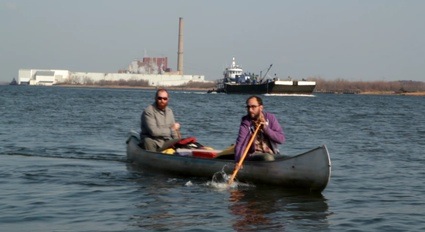 Photo credit: Elisa Giardina Papa
Photo credit: Elisa Giardina Papa
Artist Jon Cohrs, wilderness guide Ryan Van Luit and camera-woman Elisa Giardina Papa traveled by canoe down the Hackensack River, visiting various artificial flavoring factories of New Jersey, planting their tents along the way and cooking with Doritos, Tofurkey and other products that contain artificial flavors “in an attempt to bridge our understanding of the natural and artificial.”
The second part of The Spice Trade Expedition will be a vérité film that explores the shifting definition of what is “natural”.
Footage The Spice Trade Expedition
Curious blogger that i am, I contacted Jon Cohrs to ask him about The Spice Trade Expedition and some of his other projects. When he’s not camping and canoeing in New Jersey, Jon is working on creating high-end salt containing antidepressants from local water, writing a book on urban wilderness, teaching at at Parson, The New School for Design and researching sonic weapons with Audint. Finally, there’s one work most of you are probably familiar with: his Urban Prospector, a DIY, cheapo oil-sniffing tool.
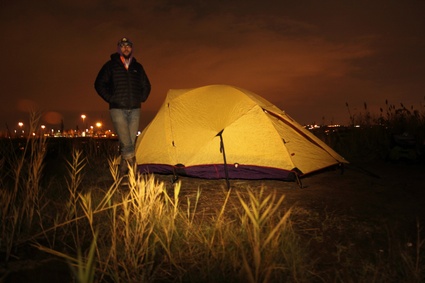 Photo credit: Elisa Giardina Papa
Photo credit: Elisa Giardina Papa
Hi Jon! The ultimate goal of Spice Trade is to produce a documentary. How far are you in the filming/editing process?
The ultimate goal of the trip is to experience the landscape from the perspective of an exploration; to travel by canoe, camp out on the landscape, live in it for a many days, and experience what it really is like. The documentary explores questions the trip raised, and how the landscape mirrors our experience with food. In addition, we are interviewing people we met along the way, local experts, and others related to artificial flavoring. We will be working on a short edit this spring and then applying to grants to raise additional money to do a full edit in the fall.
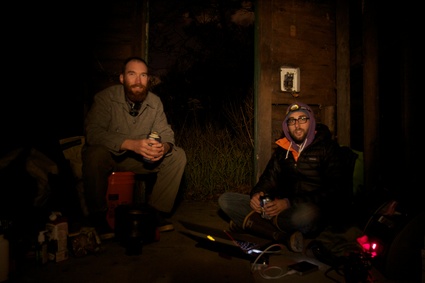 Photo credit: Elisa Giardina Papa
Photo credit: Elisa Giardina Papa
In the trailer of the documentary you explain that all along the expedition you will be eating food that has been locally and artificially flavoured. How did the experiment go? Did you suffer from any side-effect? Did you expect to get dreadful results similar to the ones experienced by Morgan Spurlock, the Director of Supersize Me?
Eating artificial foods wasn’t a big part of the trip. The emphasis of the project is really on the environment and how it relates to the surrounding industry, particularly through food and the aspect of flavor. What I find particularly fascinating is that the landscape parallels the food that is generated there; both confuse our senses about whats real and what is artificial.
As follow up to our initial trip, we took 10 more people out for a 2 day trip just after Thanksgiving. Everyone camped out and we cooked a mixture of local foods, including Goya and other New Jersey processed products, and we ate a combination of processed foods and natural foods. It was set up like a Thanksgiving feast out on top of an abandoned dump overlooking the Hackensack River, with a great view of the Manhattan skyline behind us. We all huddled around a warm fire and cooked our various dishes from which all sorts of discussions grew out of the bizarre environment we were camped out in, and foods we were eating.
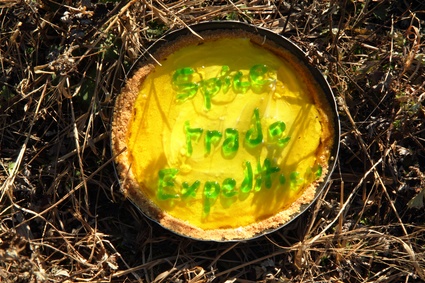 Based on your discoveries about artificial flavours, do you have any piece(s) of advice for us? Flavours to avoid at all cost for some reason? Or flavours that we might want to try? Did your findings change the way you look at food and labels?
Based on your discoveries about artificial flavours, do you have any piece(s) of advice for us? Flavours to avoid at all cost for some reason? Or flavours that we might want to try? Did your findings change the way you look at food and labels?
There is no real advice I can give except that the environments we tend to avoid can be some of the more exciting ones to explore, but that’s old news. With regards to flavors, it’s a really complex issue, but one thing is clear: no one has a clue what those ingredients and flavors mean. We’ve talked to several flavoring companies but we haven’t gotten any clear answers or explanations. More to come on that soon.
Interview with Dr. Sandra Sherman, Spice Historian, Fordham IP Institute
By the way, did you start this research with the objective of denouncing the evil of artificial flavouring? Or did you have a more neutral approach?
The approach to the subject matter is a decidedly neutral. There is no way of understanding what is in the flavorings or in most processed foods by simply looking at the labels, so it seemed appropriate to begin exploring and researching this by canoe, since many of the companies are concentrated in a post-industrial area that feels both very natural yet clearly artificial.
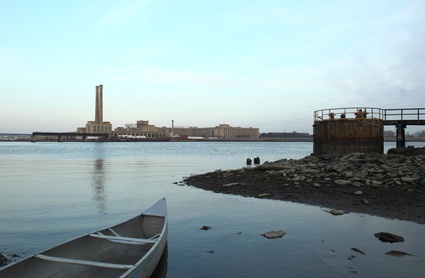 Photo credit: Elisa Giardina Papa
Photo credit: Elisa Giardina Papa
Did you discover why there is such a concentration of artificial flavour factories in the meadowlands of New Jersey?
We asked several people about this but there is no clear answer. One theory may be simply the relative proximity to NYC, a historic trading haven for spices and foods. Another theory is that it grew out of the large chemical industry in northern New Jersey that has existed for years.
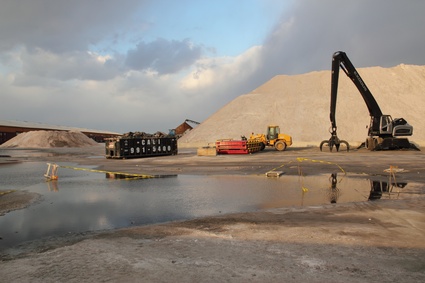 Photo credit: Elisa Giardina Papa
Photo credit: Elisa Giardina Papa
How open where the companies you interviewed to answer your questions?
They were not at all interested. They are notoriously tight-lipped about their recipes and concoctions for various flavors. But in our case we were more interested in talking with their PR representatives about what it means to confuse the senses the disconnect it represents. But surprisingly few flavor companies have PR representatives because they only deal with wholesalers or custom orders from food manufactures so there’s no need nor interest in talking with the public. This has been our biggest hurtle; not only are they very secretive, they simply don’t know what to do when some one approaches them with questions. We’ve spoken with several researchers who are well informed on the industry but the golden egg has eluded us so far. But we have a few more tricks up our sleeve, and will no doubt have the conversions we’re interested in, it just may take time.
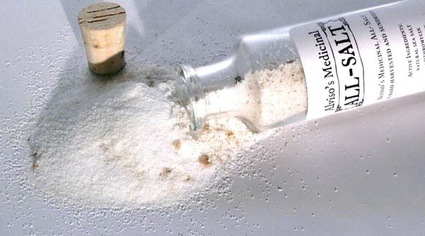 You participated to Zero1 with Alviso’s Medicinal All-Salt, a hand-harvest salt enriched with pharmaceuticals found in natural water systems. Did you try and have people actually buy/consume the salt? How did the public react to it?
You participated to Zero1 with Alviso’s Medicinal All-Salt, a hand-harvest salt enriched with pharmaceuticals found in natural water systems. Did you try and have people actually buy/consume the salt? How did the public react to it?
Alviso’s Medicinal All-Salt was a collaboration with Morgan Levy from UC Berkeley. Most of the U.S. water supply has various pharmaceuticals in them, from both from humans and livestock. We wanted to harvest them and create a perfect aggregate of what America is taking to heal itself and then turn around and sell it in cure-all salty solution. We sold the salt at the festival, online, and at an organic foods street fair. The public reaction in San Jose was good but obviously it’s a very open and left-leaning audience. The more interesting responses happened online where we were able to reach a larger non-traditional audience through various blogs. Its important to reach this online audience because that’s were one can challenge peoples assumptions and break through the noise.
I’d like to come back to an ‘older’ project of yours, the Urban Prospector. The project has been shown at several high profile art festivals but i also read that you were hoping to reach out to other audiences. Can you explain us how you imagine that the UP could be used in neigbourhoods and communities?
The urban prospector is tool designed to explore various types of the toxic compounds in ones neighborhood. It was released as a kit, and instruction set with simple steps so anyone could buy an old metal detector and build their own oil prospecting tool. It has real practical use in creating a tangible understanding of the chemicals, particularly hydrocarbons, found in our neighborhoods. It was designed to address the fifty year old oil spill in Greenpoint, NY. Traditionally our only exposure to this information is through abstract maps that don’t convey the physicality or immediacy of the exposure and damage. I think this abstraction through data-visualization can quickly confuse viewers and locals because the data cannot be viewed beyond a conceptual realm. To wander through your backyard and neighborhood with a tool creates a connection with the environment and its current state not possible through news and data.
Another important aspect is to engage people to explore their neighborhoods through a playful narrative around the idea of prospecting and getting rich, while simultaneously suggesting greed as a powerful motivator for corporate involvement in cleanup. For me, its important to address serious issues with a degree of humor, so that the issue doesn’t become overwhelming leaving the people feeling powerless.
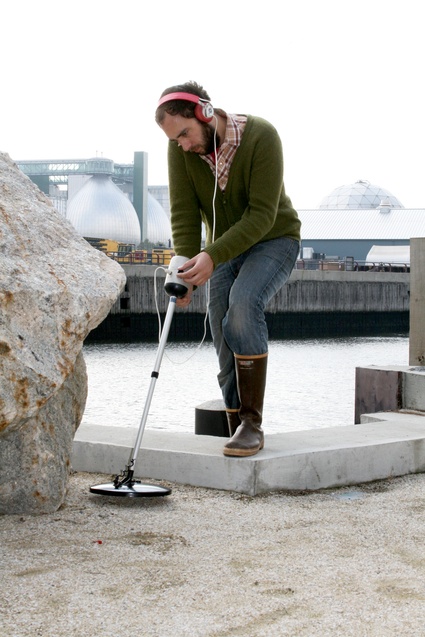 Photo by Gaby Steiner
Photo by Gaby Steiner
And more importantly did the Urban Prospector make you rich?
Yeah, I no longer drink drip coffee. I’ve moved up to espresso.
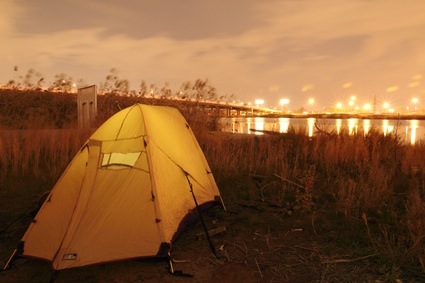 Photo credit: Elisa Giardina Papa
Photo credit: Elisa Giardina Papa
Any upcoming project you’d want to share with us?
The Spice Trade film project will be in production for at-least another 9 months or more. In the meantime I will be launching another version of my analog TV stations in Montreal for the Canadian digital transition. We’re updating the code, and have revised the web-scraper, and releasing it on git.hub. The website is OMGimon.tv and will begin broadcasting live again the first week of May.
At the end of May I have a show with a collaboration called Audint, together with Toby Hayes, Steve Goodman – author of “Sonic Warfare” (MIT Press), and myself, at Art in General that will explore the impact of sonic weapons and their use. In addition, we hope to reverse engineer a infrasonic speaker and explore its impact. In June, we will also be organize a conference with scientists, industry representatives, artists + musicians, and military representatives to discuss the use of sound as a weapon, which will (tentatively) held at Eyebeam.
Thanks Jon!
